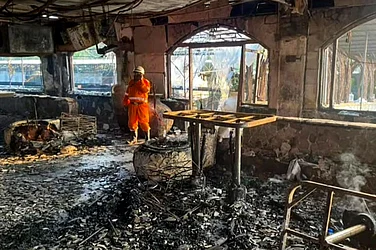Whipped up by the strong winds, as the massive fire continued to rage through Vaishno Devi’s Trikuta Hills in Reasi district, former deputy chief minister of Jammu and Kashmir, Nirmal Singh on Thursday shared a video on his Facebook page that showed a solitary old man clearing dry Chir Pine needles in another forest in Kathua’s Sukrala village. “He is clearing the fallen leaves of pine trees to prevent the spread of jungle fires,” Singh stated in his post describing the act as “inspirational”, while claiming that the video featured 93-year-old Gopal Krishan Padha, a retired range officer of J&K’s forest department.
Almost every summer, wildfire sweeps through forested Trikuta and Shivalik hills. Many elderly people in the Rajouri district, who live in areas as far as 15 km from the forest, recall how they would rush to fight fire in the wooded areas during hot dry spells when they were young. To arrest the advance of the slithering fire on the ground, they would use fronds to beat the blaze or would create firebreaks. They would help forest dwellers to clean their ponds as well. Clearly, people like Padha are a rare exception today as a forester in the Jammu division tells Outlook, “People don't show the same enthusiasm since they are not directly dependent on forest resources anymore.”
But the residents in the Sunderbani forest range blame resin extraction— which was introduced on a massive scale in the late 1980s — for general social indifference towards the forests. Although the local resin processing factory has been closed, it couldn’t revive the old social concern for the forestry. As a child, this reporter, too, has been a witness how tree trunks were incised in a fish-bone pattern to collect the sap in multiple containers attached to every single tree. It was widely believed that overexploitation of pine trees was chiefly responsible for wildfire severity and ultimate destruction of forests. Several denuded Shivalik hills remain deforested despite several attempts at compensatory afforestation.
Ever since the forests have been fenced, the role of the tribal population in protecting the forests, too, has decreased, according to Talib Hussain, a Peoples Democratic Party leader and a member of the Gujjar-Bakerwal community. “The forest rights act remains on papers only. We are yet to see its implementation in letter and spirit,” he says, elaborating how the tribal communities have traditionally played a key role in protecting forests.
Whether started on purpose, accidentally or because of natural reasons, forest fires in some regions previously not considered fire-prone have increased in northern India, scientists claim in a report for the U.N. Environment Programme (UNEP), Spreading like Wildfire: The Rising Threat of Extraordinary Landscape Fires, which was released on February 23. A study by the Council on Energy, Environment and Water (CEEW) claimed in April that wildfire incidents and total area burned, among other criteria have increased by tenfold between 2000 and 2019. There were 3,082 forest fires across states in 2000, while the number went up to almost 30,947 in 2019, the study noted, claiming that 36 per cent of India’s forest cover remains vulnerable to catastrophic forest fires.
Due to forest fires, India loses Rs 1,176 crore annually, as per a report, Strengthening Forest Fire Management in India, jointly prepared by the Ministry of Environment, Forest and Climate change (MoEFCC) and the World Bank. But the government allocates only Rs 45-50 crore a year under the Forest Fire Prevention and Management Fund, according to experts. Considering that forest fires remain the biggest reason for forest degradation in India, a National Action Plan on Forest Fires was launched by the MoEFCC in 2018. A parliamentary standing committee report in 2019 had admitted that shortage of funds had been keeping the department from developing and strengthening early warning systems.
“The UNEP study (predicts) a 50% rise in wildfires by 2100. This is a global estimate and not particular to India – and is a result of a combination of climate change but also land-use change,” Rajesh Thadani, executive director of Centre For Ecology Development And Research, Dehradun, tells Outlook, describing the study as “robust and not specific to North India.” In CEEW’s study report, Thadani says, “Forest fires are very variable from year to year – and there will be years when there will be 10 times more fires than other years. But I do not think there is anything close to a trend which indicates a 10 fold rise in intense fires in India over the past 10-20 years.”
Thadani believes that fires are usually intentionally burnt to clear away pine needles and promote better grass growth for cattle, for example. While forest departments in Himachal and Uttrakhand have decided to use Chir Pine needles as a bioresource for making fibre, the J&K forest department has been encouraging the use of the biomass for handicraft items such as baskets, doormats and coasters.
On risk mitigation and wildfire management in North India, Thadani says, “The ways to mitigate have not changed much in the past century or more. There has been a decrease in community participation in fighting fires and this is worrying. The forest department has limited resources and without community participation, it is very difficult to fight fires. There is a need to build trust between the forest department and local communities and to involve them in fire fighting. Better awareness dissemination can help reduce fires and training of the community to control fires may help.”
On a few occasions in the recent past, Indian Airforce Choppers have been deployed to douse wildfires in J&K and Uttrakhand. “It makes a great visual spectacle when helicopters are called in to throw water on and douse fires. But this is neither cost-effective nor practical and nor will it work in the majority of fires. In the end, it is the traditional and low technology methods, digging fire lines and breaks, and using human effort that is most practical to fight fires,” he says, cautioning, “When it comes to fighting fires, technology has limitations.”
Amid rising global temperatures due to climate change, he says, the higher heat has been making forests more dry and combustible. “Fires in Uttarakhand typically occur in March-May and are much worse when the ground is particularly dry – i.e. when there has been little or no rains in the late winter in particular. If rainfall is poor then the fire season will be bad,” he explains, adding that erratic rainfall patterns are also damaging due to higher chances of long drought periods which turn the landscape into tinderboxes. And in many areas, Thadani warns, “Forest fires are becoming a major concern and highly destructive crown fires, which seem to be increasing in frequency, can completely burn down forests and it make takes tens of years or more for any kind of recovery.”


























